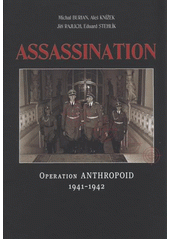 Assassination: Operation Anthropoid: 1941–1942 by Michal Burian, Aleš Knížek, Jiří Rajlich, and Eduard Stehlík (ISBN: 80-7278-158-8) tells the story of one of the better-known assassinations in World War II, that of Reinhard Heydrich, the commander of the Reich Security Main Office (RSHA), acting governor of the Protectorate of Bohemia and Moravia, and a principal architect of the Holocaust. The operation was conceived by Czechoslovaks in exile in the UK, but carried out by paratroop commandos in occupied Czechoslovakia in concert with local members of the resistance. Like many of the operations in occupied Czechoslovakia, most of the people involved ended up dead. Radio operators, paratroopers and soldiers, resistance members who helped the paratroopers hide, farmers who lent a place to stay or a warm meal, all of them met the same fate once the Nazis discovered that they were in any way associated with the efforts against Germany. Thankfully for the Czechoslovaks, there were enough people that were willing to risk it all, and two of the paratroopers who had undergone intensive and extensive training in the UK, Jozef Gabčík and Jan Kubiš, were able to execute their plan against Heydrich. The plan was to shoot him, but that didn’t initially work, so a bomb was tossed toward his car. The explosion, which happened just outside the back of the car, didn’t kill Heydrich initially, and the attackers had to run away, chased for a short distance by their target. A week later, Heydrich succumbed to his wounds, and in the coming weeks, Nazi reprisals wiped out complete Czechoslovak towns and eventually also wiped out Gabčík and Kubiš.
Assassination: Operation Anthropoid: 1941–1942 by Michal Burian, Aleš Knížek, Jiří Rajlich, and Eduard Stehlík (ISBN: 80-7278-158-8) tells the story of one of the better-known assassinations in World War II, that of Reinhard Heydrich, the commander of the Reich Security Main Office (RSHA), acting governor of the Protectorate of Bohemia and Moravia, and a principal architect of the Holocaust. The operation was conceived by Czechoslovaks in exile in the UK, but carried out by paratroop commandos in occupied Czechoslovakia in concert with local members of the resistance. Like many of the operations in occupied Czechoslovakia, most of the people involved ended up dead. Radio operators, paratroopers and soldiers, resistance members who helped the paratroopers hide, farmers who lent a place to stay or a warm meal, all of them met the same fate once the Nazis discovered that they were in any way associated with the efforts against Germany. Thankfully for the Czechoslovaks, there were enough people that were willing to risk it all, and two of the paratroopers who had undergone intensive and extensive training in the UK, Jozef Gabčík and Jan Kubiš, were able to execute their plan against Heydrich. The plan was to shoot him, but that didn’t initially work, so a bomb was tossed toward his car. The explosion, which happened just outside the back of the car, didn’t kill Heydrich initially, and the attackers had to run away, chased for a short distance by their target. A week later, Heydrich succumbed to his wounds, and in the coming weeks, Nazi reprisals wiped out complete Czechoslovak towns and eventually also wiped out Gabčík and Kubiš.The book was an interesting look into one of the more important resistance moments in Czechoslovakia during World War II. I was a little surprised by the book because I thought it would be a regular book with a lot of text, but it was actually a coffee table book (I read a PDF version of the book available on the Czech Ministry of Defense’s web site) that essentially re-created what seemed to be a museum exhibition about the assassination. The book was full of pictures of artifacts and didn’t have all that much text. Still, it was easy to follow what was going on and there was lots of information. Even though Heydrich was a very important Nazi, I didn’t know a whole lot about this event, and thought this book was informative and explained the run-up and planning, the operation itself, and the sad aftermath well.

|
This work, including all text, photographs, and other original work, is licensed under a Creative Commons Attribution-NonCommercial-NoDerivatives 4.0 International License and is copyrighted © MMXXI John Pruess. |